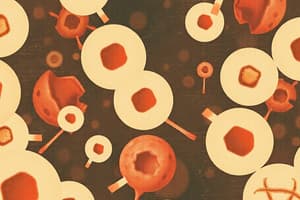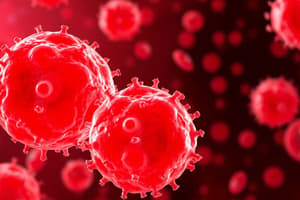Podcast
Questions and Answers
Describe neutrophils?
Describe neutrophils?
most common white blood cell, they are neutral pink and multi lobed with 2-5 lobes. They function in innate immune system and do phagocytosis and degranulation. They mainly are located in the skin & mucous membrane and they life for a few hours to a few days. They respond to inflammation and bacteria and fungi. They go to blood vessels and intersistial tissue.
Describe eosinophils?
Describe eosinophils?
make up 1-6% of white blood cells. They are red and bi-lobed. They function in degranulation. Releasing enzymes and growth factors as well as cytokines and life for a few days. They respond to parasites, allergic reactions. They are located in the thymus, GI tract, an spleen. They defend by degranulation
Describe basophils?
Describe basophils?
least common white blood cell. They are either bi or tri lobed. They function in degranulation, releasing histamine, enzymes, and cytokines. They respond to allergic reactions, inflammatory reactions. They are located in small numbers in the blood vessels. They defend by releasing heparin and histamine.
Describe monocytes?
Describe monocytes?
Describe lymphocytes?
Describe lymphocytes?
What is acute lymphoblastic leukemia (ALL)?
What is acute lymphoblastic leukemia (ALL)?
What is Measurable Residual Disease (MRD)?
What is Measurable Residual Disease (MRD)?
Describe B-cell chronic lymphocytic leukemia (CLL)?
Describe B-cell chronic lymphocytic leukemia (CLL)?
Acute myeloid leukemia (AML)?
Acute myeloid leukemia (AML)?
what is acute promyelocytic leukemia (APL)?
what is acute promyelocytic leukemia (APL)?
Chronic Myeloid Leukemia (CML)?
Chronic Myeloid Leukemia (CML)?
(FISH) FLuorescent in situ hybridization?
(FISH) FLuorescent in situ hybridization?
Flashcards
T cell
T cell
A type of white blood cell involved in the adaptive immune response, with roles in cell-mediated immunity.
Helper T cell
Helper T cell
A subtype of T cell that produces cytokines to enhance the immune response.
Cytotoxic T cell
Cytotoxic T cell
A type of T cell that releases toxins to kill infected or cancerous cells.
B cell
B cell
Signup and view all the flashcards
Natural Killer Cells (NK)
Natural Killer Cells (NK)
Signup and view all the flashcards
Acute Lymphoblastic Leukemia (ALL)
Acute Lymphoblastic Leukemia (ALL)
Signup and view all the flashcards
Measurable Residual Disease (MRD)
Measurable Residual Disease (MRD)
Signup and view all the flashcards
Lymphoblast
Lymphoblast
Signup and view all the flashcards
Frontline Therapy
Frontline Therapy
Signup and view all the flashcards
B-cell Chronic Lymphocytic Leukemia (CLL)
B-cell Chronic Lymphocytic Leukemia (CLL)
Signup and view all the flashcards
Symptoms of CLL
Symptoms of CLL
Signup and view all the flashcards
Diagnosis of CLL
Diagnosis of CLL
Signup and view all the flashcards
Fluorescent in situ hybridization (FISH)
Fluorescent in situ hybridization (FISH)
Signup and view all the flashcards
Acute Myeloid Leukemia (AML)
Acute Myeloid Leukemia (AML)
Signup and view all the flashcards
Symptoms of AML
Symptoms of AML
Signup and view all the flashcards
Diagnosis of AML
Diagnosis of AML
Signup and view all the flashcards
Acute Promyelocytic Leukemia (APL)
Acute Promyelocytic Leukemia (APL)
Signup and view all the flashcards
Myeloid Sarcoma
Myeloid Sarcoma
Signup and view all the flashcards
Leukocytes
Leukocytes
Signup and view all the flashcards
Hematopoietic Stem Cell
Hematopoietic Stem Cell
Signup and view all the flashcards
Leukocytosis
Leukocytosis
Signup and view all the flashcards
Leukopenia
Leukopenia
Signup and view all the flashcards
Granulocytes
Granulocytes
Signup and view all the flashcards
Neutrophil
Neutrophil
Signup and view all the flashcards
Eosinophil
Eosinophil
Signup and view all the flashcards
Basophil
Basophil
Signup and view all the flashcards
Monocyte
Monocyte
Signup and view all the flashcards
Lymphocyte
Lymphocyte
Signup and view all the flashcards
Study Notes
Leukemias
- Leukemias are cancers of white blood cells (WBCs) or leukocytes
- WBCs are part of the immune system and are primarily found in blood and lymphatic systems
- WBC count (WBC#): 4-11 x 109/L (microliters)
- Leukocytosis: WBC count above normal
- Leukopenia: WBC count below normal
Types of Leukocytes
-
Granulocytes: contain visible cytoplasmic granules
- Neutrophils (40-75%): most common WBC, multi-lobed, stain neutral pink, phagocytic, fight infection, short lifespan
- Eosinophils (1-6%): stain red, bilobed, respond to parasites and allergic reactions, have enzymes to fight parasites
- Basophils (<1%): stain dark blue, release histamine and other chemicals involved in inflammatory response
-
Agranulocytes: do not contain visible granules
- Monocytes (2-8%): largest WBC, kidney shaped, become macrophages, important in phagocytosis
- Lymphocytes (20-40%): diverse functions in immune response, including cell-mediated immunity. T cells, B cells, and Natural Killer (NK) cells.
Specific Leukemias
- Acute Lymphoblastic Leukemia (ALL): Overproduction of immature lymphocytes (lymphoblasts)
- Chronic Lymphocytic Leukemia (CLL): Most common leukemia in adults, affects B cells. Characterized by buildup of mature lymphocytes and often has a later onset
- Acute Myeloid Leukemia (AML): Cancer affecting myeloid cells; rapid growth of abnormal myeloblasts in bone marrow, preventing normal blood cell production
- Chronic Myeloid Leukemia (CML): Unregulated growth of myeloid cells in the bone marrow, resulting in an accumulation of mature granulocytes in blood and has a specific chromosomal translocation.
- Myelodysplastic Syndromes (MDS): Ineffective hematopoiesis (blood cell production) that involves the bone marrow. Risk of transforming into acute leukemia.
Studying That Suits You
Use AI to generate personalized quizzes and flashcards to suit your learning preferences.




